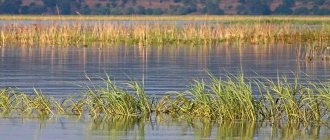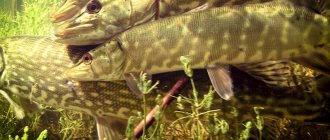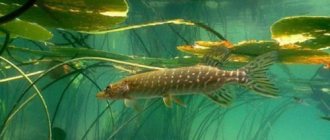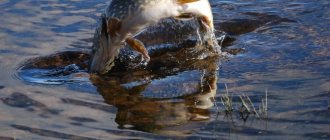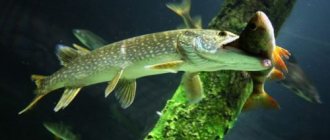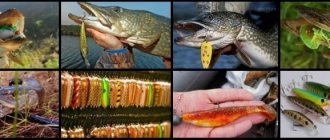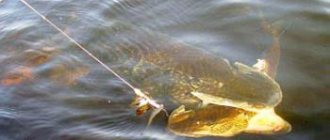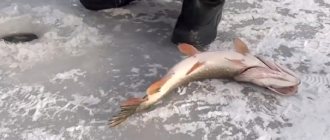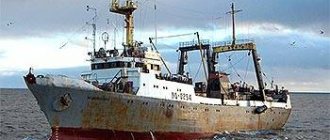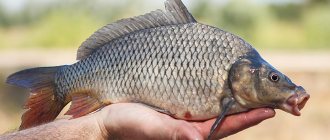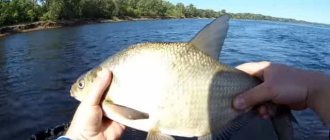Content
- How to catch a trophy pike?
- Selecting a location
- Temperature and water level
- Gear selection
- Fishing technique
- Total. The secret is simple
- Interview When does the autumn feeding season for trophy pike begin?
- How to choose the right place to look for a trophy?
- Best lures in your opinion? Tell us in general about the fishing technique.
- What advice do you have for beginners who dream of their first trophy?
We couldn’t help but touch upon the most burning topic of the autumn season, which worries the hearts and minds of the vast majority of spinners. Where the hell can I find this trophy? And how can you finally catch him?
Conclusion
The autumn feeding period of pike, aimed by nature at preserving the species, is the best time for fishing for the toothy predator. I would like to wish fishermen, in addition to good catches, respect for nature, not to take with them a large number of caught fish, releasing most of the tails, especially small ones, back into the reservoir. You can read about other seasonal species of zhora predator here.
Autumn is the best time for beginners in pike fishing with various tackles. It is at this time that the fish forgives many mistakes due to its activity.
How to catch a trophy pike?
In this article, I tried to succinctly formulate the main rules and postulates that will help you catch a trophy specimen.
Outwitting an old, wise predator is not easy; it’s not for nothing that no one has been able to do it for so many years. Anton “Fisher-man” Kharlanov , who during his fishing career has brought more than one old grandmother on board, will help us with this In addition, after his recent successes in fishing tournaments, many will probably be interested in his thoughts, understanding and approach to trophy fishing.
Read the interview with him at the end of this article. In the meantime, general thoughts - “How to catch a trophy pike?”
Selecting a location
This is one of the fundamental questions that needs to be addressed. There is no point in dipping bait in the water when you don’t end up either in “mom’s” house or on her table.
Of course, to successfully find such places and have full access to them, you will need a boat and a modern echo sounder. With an echo sounder that shows the relief well and allows you to distinguish snags from boulders, and rocks from steep slopes, your search will be much more successful.
First of all, you should pay attention to the deepest parts of the reservoir, no matter how trite it may sound. Explore in detail the surroundings of these pits, exits from them for irrigation, spits and shallows where the predator will go to feed. There may be many such places on the river and sea, but not all of them attract large fish. On the river, you should pay attention to holes in which the current will be moderately weak. A large, wise fish will not stand in heat and constantly fight it. First of all, this is a river that borders the main fairway channel, but the flow in them slows down significantly. The relief should be built in such a way as to form a current boundary, nearby participants of a strong and weak stream, a “return”, and nearby exits to small spits and irrigation.
The navigational guide greatly helps in finding promising places; modern maps in a chartplotter with depth contours are even better.
If in such places there is heterogeneous and unusual terrain, the chances of meeting good fish increase sharply. Rocky ledges where the current calms down, local snags, boulders at the bottom, behind which it is easy for a predator to find shelter, increase the likelihood of capture.
Of course, in these places there should be concentrations of white, forage fish. The more factors described above you find in one place, the greater the likelihood that your target lives somewhere here!
From personal observations, I will also note the following theses:
- Local one or two snags will work better than an extensive underwater forest. This makes it much easier to find a fish and get it to bite than to throw a windbreak at it.
- In coastal, even deep snags, pike up to 5-7 kg in size are most often caught. Real grandmothers live closer to the riverbed .
- really large pike to bite . Either you will be incredibly lucky, or you need to wait for the exit. This is quite passive fishing - standing, methodically selecting bait. Please be patient .
- There are many ways to place a boat in one fairly local spot. Don't neglect this. Often it is the correct placement and presentation of the bait that makes the difference!
- And, of course, one of the main factors for successful capture is simple - “the further into the forest, the more firewood.” The less pressure and the more inaccessible the fishing spot, the higher the chances of catching a trophy .
Temperature and water level
Autumn, after all, is the best time for fishing.
- Firstly, the water level drops significantly and the fish begin to concentrate. White fish gather in large schools, which makes it easier for both fishermen and predators to find them.
- Secondly, the instinct of “the approach of winter” is triggered. Active feeding begins when the temperature drops below 15 degrees. From 13 to 8 is the optimal value for pike zhor.
But you need to understand that fish always eat. It just becomes a little easier to catch in the fall. But the first bursts of activity and the capture of trophies begin with the first noticeable drop in water in the river and the first cold, foggy nights. Late July-early August. And then gradually, if only the autumn weather pleases with stability, and not with sudden changes and pressure drops.
Monitor the water level and temperature - these graphs are a good help to navigate in time and predict the bite.
When is the best time for pike to bite in the fall?
During the seasonal feast, weather conditions have little effect on the activity of individuals. Pike can also be caught in sunny weather, but cloudy weather is preferable - in cloudy weather there is poor lighting in the water, the fish cannot accurately see the object.
The main condition for a good bite is to get to the “exit” of the pikes. In September it is preferable to fish in the morning and evening. Starting from October, the daily activity of pike shifts; biting begins no earlier than 11 o’clock in the afternoon, with peak activity at noon. The ideal day for a quiet autumn hunt is cool, cloudy, with light or heavy rain. At this time the pike bites best.
Gear selection
This is where many inexperienced anglers make mistakes. It would seem that the understanding that when hunting for crocodiles you need reliable gear should be self-evident. Probably, beginners do not understand this until they hold and feel the real “submarine” at the other end of the cord.
- Firstly, forget about unnecessary accessories - clasps, carabiners, swivels - all this is the first thing that will break and be a reason for an unfortunate derailment. Just a string tied to a braid - nothing more.
- Secondly, no fluorocarbon leader, of course. Forget about it when it comes to grandma's teeth.
- The length of the steel leash should be at least 35-40 cm. Twist two together if you don’t have a suitable one at hand.
- High-quality braid that does not split from the first contact with driftwood and shell, not lower than 1.5PE .
- A rod capable of forced fishing of the Heavy , no lower. The system is probably chosen for an amateur, but it is better if it is “Extra Fast” , which allows you to have good control of the bait in the current and great depths, and not fail during a powerful hook, which is important.
- Class 4000 traction reel - leave less for fooling around with okushki.
- High-quality hooks are a very important point. Jaws of such strength simply break and unbend hooks with a quality “slightly lower than the best.”
- And, of course, a landing net. A large, reliable landing net and a skillful partner! This is also very important.
Pike fishing during the zhora period
If you plan to fish from ice, you need to be careful. After all, in March it ceases to be durable.
Before spawning, fish are not tempted by large baits; there is no point in using them. The fish feeds often, but little by little. In the spring, those baits that fishermen wouldn’t even think of putting in the fall work well. For example, a small twister or vibrotail, which are suitable for pike perch. Traditional pike lures work worse.
You should fish in places that are suitable for predator ambushes. For example, depressions next to flooded logs and trees or snags.
Fishing technique
A question that is difficult to fully disclose and explain on paper in one article.
- First, use large baits. A big piece makes your mouth happy. Silicone less than 10 cm or 3.9 inches does not make sense at all when you are aiming for a trophy. The optimal size for searching is 4.5-5 inches, which will allow you to catch large pike, and not be completely bored, also picking up a “one and a half pike”. The deeper into autumn, the larger the bait and the slower its presentation. Only when it’s already approaching winter, and the fish become completely inactive, reducing the size of the bait can give more bites and improve the result.
- Secondly, if you haven’t caught on streamers, now is the time to start. Large foam rubber from 120 mm will also come to the rescue - it is especially effective when fishing from under snags.
The technique of placing a jig itself (and we are not even considering the “Retractable Leash” and “Carolina Rigging” here) is an art that comes with time. It is important to master a variety of wiring and change them, try them, select them. As I already noted, catching a trophy in a pressed reservoir often means standing at one promising point, picking up bait and waiting.
In general, it can be noted that you should not wait for a bite from a crocodile by sharply and quickly feeding the bait. A large individual is not inclined to waste extra energy and play catch-up. Unless in this way you can “swing” and encourage the fish to bite on the next casts, specifically using a smoother, rolling retrieve after the active one.
It is worth paying attention to fishing with jerks and deep-sea wobblers . Large lures of this class are definitely pleasing to the eye of large pike. This is not a very common method of fishing in our area, but in vain. This can be your trump card when the jig is silent.
Large pike respect streamers and jerkbaits.
The influence of weather on pike biting in autumn
Pike does not like sudden changes in temperature and pressure. It is important to take into account the weather preferences of the predator to ensure maximum catch. So, what is the optimal weather for biting and when is the best time to fish?
Pressure
Has a greater influence on fish activity than the direction and strength of the wind. The main requirement is stability. The bite is more intense at lower pressure. Ideal atmospheric conditions for pike fishing are from 750 to 760 mm.
Wind
The toothy one is active in weak, warm winds. It is optimal to go hunting if the southwest wind blows. Undesirable directions – eastern, northern. In the complete absence of wind, it is easier to cast a spinning rod, but the pike is more careful at this time (when it is calm, it sees the fisherman).
Temperature
Optimal indicators are from +8 to +13. The water stops blooming and overheats, the predator senses the approaching cold weather and goes hunting.
Total. The secret is simple
The more often you go to the reservoir and the more you experiment with gear, wiring and discover new places, the faster you gain experience and depth in understanding fishing and finding the right promising places. Experience that you will subsequently use to catch the coveted trophy. And one of the most important factors that greatly increases your chances is the inaccessibility and remoteness of fishing spots from big cities. It's corny, simple, but it's true. And now I bring to your attention an interview with a successful trophy hunter.
Advice from experienced people
- To guarantee success in catching the coveted trophy, it is recommended to choose the right time and place.
- Particular attention should be paid to the choice of bait; on each specific body of water, the taste preferences of the predator can differ significantly from each other.
- Tackle for pike hunting can be very diverse, but they all must be of high quality and well-equipped.
poklevok.net
When does pike get hungry?
- I agree with the author of the best answer. However, it’s not clear from the answer when it’s fat. Therefore, I will try to approximately determine the periods for the central zone of Russia. If you start from the beginning of the year, then the first zhor begins in the spring before spawning. Usually this is the end of February - beginning of April. It all depends on the weather and water temperature. Even if not all the fish go to spawn at once, the bite stops and empty bites alternate with small male squirrels. The second zhor after spawning before the change of teeth. On the rivers it is the end of April - the beginning of May, on the lakes - May. The zhor does not last long, about a week and also depends on natural factors. The next obvious glutton is in July. It lasts a week and, according to my observations, usually takes place between July 5-26. Then there was a pause, but from August, as soon as the water became cooler, the pike bite was quite stable. At the same time, you can set aside time for eating. This is November - December if the beginning of winter is mild or October-November if it is severe. Something like this.
- The pike has a zhor after spawning (during spawning it does not eat anything), this is the beginning of mid-May (depending on the water temperature), and immediately after freeze-up (on the first ice) - it accumulates fat for the winter (October-November).
- Pike eats twice a year, roughly in spring and autumn. Moreover, the spring feeding of pike turns out to be divided into unequal halves by spawning. Pike actively feeds, and therefore is caught, a week and a half before spawning, and another 2-3 weeks a week after spawning. Pike spawning begins around the end of March, when the water is already starting to warm up. If the spring turns out to be cold and the ice leaves the reservoirs late, then spawning moves to April. In autumn, pike also eat actively, and begin to eat away from the end of August to mid-October. Almost the autumn feeding period of pike lasts until the beginning of freeze-up. But on days when there is a sharp change in pressure, the pike stops eating and waits for better weather.
- Let's first define what quot;zhorquot; is.
The moment of spawning is called quot;spawningquot;. At this moment the pike does not eat. But there is not just one individual in the pond, there are many of them. And pike lay eggs longer than other fish. Therefore, the spawning time is longer than for other fish, almost two weeks.
Shuka is always gluttonous, but gluttony occurs only before spawning, but also after it. That’s why spawning time is called zhor. Before spawning, she gains strength to spawn, and after spawning, in order to restore her body. And since the young ones spawn first, and then the adults, the food goes on throughout the entire spawning process.
This period itself is determined by geographic location and the water in which the pike lives. In the north this is usually from May to the end of June. And as it moves closer to the south it moves closer to the winter months. In the very south (for example, in the Don), pike emerge from the pits already in February and go to the shallows to feed and prepare for spawning.
Each fisherman can tell his own story about spawning time. But any fish activity cannot be called zhor. Zhor occurs before and after spawning, if you take a separate individual. And since they do not spawn on the same day, the zhor continues throughout the entire spawning period of all the pikes in the pond.
- As a rule, pike eat 2 times during the open water season. Spring zhor usually lasts 10 - 15 days and in the middle zone begins on the 10th - 20th of May and continues until the beginning of June.
Autumn feeding for pike usually begins at the first cold snap and sometimes begins in early August and lasts until late autumn.
info-4all.ru
With the onset of spring and the beginning of the feeding season, the pike is still too weak and unable to chase the nimble baitfish. The predator stands at a depth, most often no more than one to two meters, where there are infrequent snags and little vegetation. The pike attacks the unwary prey from an ambush when it is almost at the very nose of the predator. You can catch pike both from the shore and from a boat. Potka.ru recommends using GLADIATOR boats for fishing or hunting, reviews of which are the most positive on the Internet.
With the onset of spring, pike should be caught with baits that move at a minimum speed, maintaining the amplitude and rhythm given to them. In the first spring days of spring, it is better to fish with a light spinning rod, which can be used to throw baits no larger than 10 - 15 grams. Ideal spinners are those that, at a low retrieve speed, are capable of making regular oscillations away from the axis of the direction of movement, with an amplitude of no more than 10 - 15 cm. The “rotating petal” spinner is the most suitable of the other rotating spinners. The weight of this spoon, as a rule, rarely exceeds 10 - 12 grams, and the angle between the axis and the blade should fluctuate between 50 - 60o. The spoon should be cast in the bottom layer at minimum speed. No acceleration or disruption of the wiring rhythm. It is unacceptable.
With the onset of spring, pike also react well to floating wobblers, the diving depth of which is no more than 1.2 - 1.5 meters. After hitting the surface of the reservoir, the wobbler begins to slowly go deeper, and the angler must evenly reel it towards him while in a boat or on the shore. To keep the bait at a given depth as long as possible, the tip of the spinning rod should be pressed against the water.
As the water warms up to +10°C, pikes begin to have a spring meal. In an effort to satisfy its hunger, the spotted predator loses the slightest signs of caution and prudence, and you can catch it almost all day long, when the sun is shining, using any type of artificial bait. During this period, the bait itself plays practically no role, and everything depends on how the angler is able to deliver and guide the lure into the pike’s field of view. This period of “fishing happiness” lasts no more than 1.5 - 2 weeks, and as the first underwater vegetation appears, such activity of the pike disappears.
comments powered by HyperComments
plotka.ru
Interview
Anton “Fisher-man” Kharlanov – Winner of the “Obskaya Zaruba 2019”, 2nd place - “Golden Autumn 2019”, winner and prize-winner of many boat and shore competitions of past years, participant and youngest participant of the Russian Boat Spinning Championship 2013, first sportsman discharge.
Alexey: “Anton, good afternoon. First of all, I congratulate you and your partner on second place at Golden Autumn 2019 - an enviable success! Immediately after the “Obskaya Zaruba”, taking second place at another major tournament among dozens of athletes is an excellent result!”
Anton: “Thank you, Alexey, we are trying :)”
A trophy pike that brought victory to the “Let’s Reach the Goal” team at the Ob Race 2021.
When does the autumn feeding season for trophy pike begin?
Anton: “Fishing for trophy pike begins in the summer, from mid-July, sometimes from the beginning, depending on the water level. Usually the first mothers are caught when the water has dropped so much that the flooded coastal bushes are exposed. This is a level below two meters according to the Novosibirsk gauging station. I’m talking about the water area from Novosibirsk to, say, the Siman channel. After the confluence of the Tom, the conditions are already different, but there are tens of times more trophy pike there. I would not say that the closer to autumn, the greater the chance of catching a crocodile; the end of July - August is often no less productive in the tens.
How to choose the right place to look for a trophy?
Anton: “Based on my practice and observations, I can name only three types of places:
- Channel spits and midstreams;
- Exits from deep, extensive pits;
- Deep (5-7m) long snags with a moderate current.
In the snags and pits, she spends her time, so to speak, lives, and comes out to the spits from the riverbed just to eat. There is one more place where she can either leave the riverbed to eat or just live there - these are vast sands with large dunes, but such relief is found only below the confluence of the Tom.”
Best lures in your opinion? Tell us in general about the fishing technique.
Anton: “There is no universal recipe here. A crocodile can be caught with equal success both on standard rubber 5-12 cm and on huge fleshy 15-25 cm baits. There are no fewer mothers caught on a 5 cm tiny vibrotail or twister than those caught on a huge silicone. And, of course, large 15-25 cm streamers should be present in the arsenal.
Fishing is not difficult, but if the choice of places is limited, you are not in the Tomsk region, but on our meager stretch of the river, and you know only one place where it can be, all that remains is to stand at the point all day waiting for it to feed, and sort out baits and wiring. Sometimes you just need to get under her nose and she will bite, and sometimes she will need a special bait or wiring. You drive under her nose, but she doesn’t take it, she’s waiting for the right bait for the day. There are no universal recipes; preferences can change every day.
My fishing scheme is as follows: I stood in the place where I expected it to be. I make 10 wires with medium silicone. Then I put in something large, about 20 centimeters. An important note here is that when fishing with large rubber, the retrieve should be as smooth as possible, with pauses for at least 3-4 seconds. If on rubber up to 5 inches a pike can bite on very sharp and aggressive wiring, then on large rubber you need maximum smoothness. The same applies to large streamers.
In snags, the streamers disappear, leaving silicone on the offset and foam rubber with pressed doubles.
Then eternal torment begins, either it’s not here, or it doesn’t bite) In the pit, where it’s definitely there, you spend the whole day sorting out baits, on the spit you spend the whole day waiting for the exit)) In the Tomsk region it’s easy, there’s a lot of large pike there - you’re riding in promising places and catch them. In a day of moving and fishing, among the exciting fishing for medium-sized pike, you will catch the coveted “ten ten”.
What advice do you have for beginners who dream of their first trophy?
Anton: “The main advice for beginners is to buy a normal landing net. It should be large - at least 70 by 90 cm. Don’t be afraid of the gigantic size of the net; on a large pike you will understand why it is needed. The net must also be durable, with a strong frame, strong connections, and a strong mesh. I have a landing net from BFT - I have never seen a better net. Well, if you catch a trophy on the hook, if you are not fishing in snags, be sure to loosen the clutch, the load on the tackle is prohibitive, and with a sharp jerk the cord may burst or the hook may break.”
